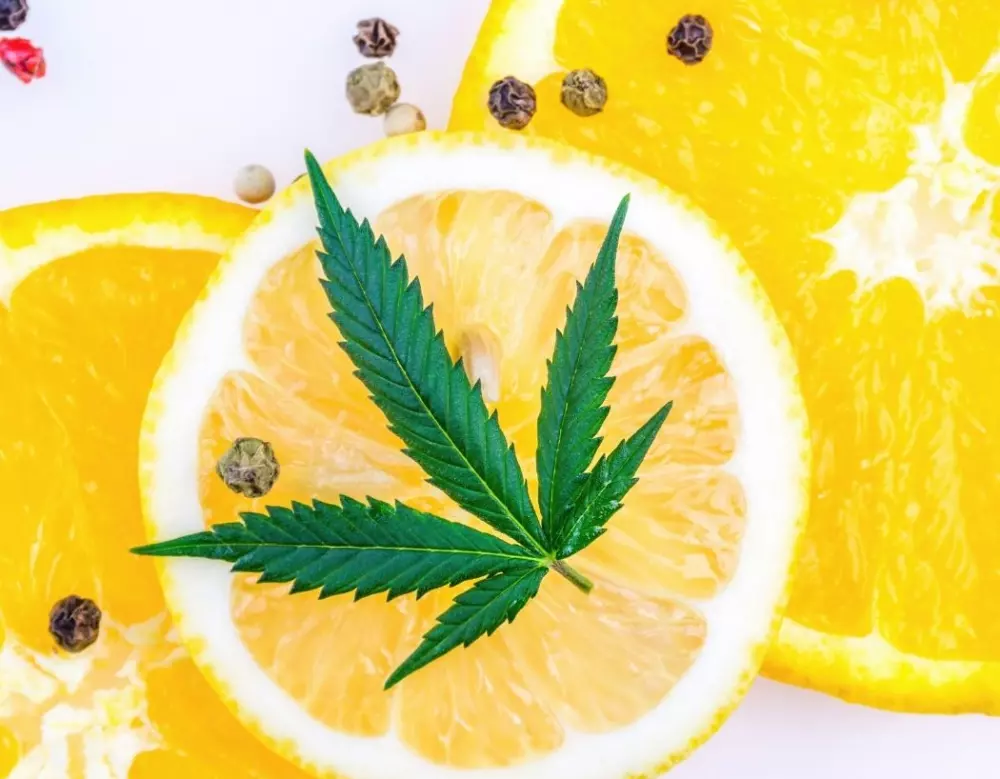The coolest thing about terpenes is that even if this is the very first time you’re seeing this word, you already know and love terpenes. Although we talk about terpenes a lot in cannabis, they’re a widespread class of molecules that you encounter every day in the food you eat, and the plants and botanicals in the world around you.
Terpenes are evaporative aromatic molecules that are responsible for the specific scents of a wide variety of plants, herbs and fruits. They’re responsible for the smell of the forest, the sweet aromas of your garden, and some of the flavors you love best in food. They’re produced by the resinous glands in plants like rosemary and lavender, and — you guessed it — cannabis! In cannabis, these glands are called trichomes, and look like the tiny white, glistening structures on buds. Trichomes produce cannabinoids, and also churn out the fragrant terpenes we’ve come to recognize as the signature scents of weed.
A Unique Aromatic Thumbprint
In addition to wafting of a general “weedy” smell, each strain has its own terpene profile. This is a unique aromatic thumbprint that gives each strain its own specific flavor, ranging from bright and spicy to sweetly subtle. Using terpenes as a starting place, you may begin to evaluate cannabis according to some of its signature aromas and characteristics. Learning to decipher their language is essential in making the most out of your cannabis experience, and will help you pick strains that taste great. And it couldn’t be easier: simply use your nose! In addition to their aromatics, when combined with cannabinoids, thanks to the entourage effect, terpenes can work alongside cannabinoids to give strains a certain experience. Terpenes have even been known to interact with the endocannabinoid system itself, further indicating that they are one of the key mechanisms in understanding how a cannabis strain will make you feel.Learn to Identify Your Favorite Flavors
In addition to the role they play in helping you find the right flower, when it comes to concentrates, terpenes can drive clear, pure flavor expressions. Unsurprisingly, both cannabinoids and terpenes are, well, concentrated in these products, resulting in robust flavor profiles and terpene presentations that make extracts one of the most flavorful ways to experience cannabis. Although there are thousands of terpenes in the botanical world, there are few key terpenes we focus on in cannabis. These five terpenes can help you categorize cannabis strains by flavor and aroma and can indicate what type of high and effect you can expect.A Guide to 5 Key Terpenes
This handy list will to help you evaluate your cannabis, and understand the ways terpenes present in some of your favorite strains.- Limonene: Think citrus! Limonene in the botanical world drives the signature flavors of the citrus family, with the oily glands of their peels producing the terpene as part of the plant’s natural defense mechanism. Limonene can be found in oranges, lemons, and grapefruits, and has been known to have anti-bacterial, anti-fungal, and even antioxidant qualities. While both classic “indica” and “sativa” strains contain limonene, high-limonene strains are known for their uplifting, invigorating qualities. Look For: Things that smell like citrus! Strains: Berry White, Strawberry Banana, Super Sour Diesel, Sunset Sherbet, Super Lemon Haze, Wedding Cake
- Pinene: From pine trees to rosemary, pinene (specifically, alpha-pinene) is produced in a wide variety of conifers and herbs and is the most abundant terpene found in nature. Pinene has been shown to produce anti-inflammatory, neuroprotective, and anti-depressant qualities, and if you’ve ever experienced the invigorating breathing-in of clear, fresh mountain air, that’s pinene and its bronchodilating effects in action. Because pinene is such a great anti-inflammatory, it’s one of the most effective terpenes in pain management. Look For: Things that smell herbaceous and foresty. Strains: Jack Herer, Blue Dream, Bubba Kush, Harlequin
- Myrcene: Myrcene is the most abundant terpene in cannabis and is responsible for many of the plant’s signature flavors. Found in mango, hops, lemongrass and thyme, myrcene has deep, heady, ripe aromas of tropical fruits laced with gasoline. With deeply relaxing qualities, strains high in myrcene are great end-of-day and wind-down smokers. Look For: Potent, musky, fruity, earthy flavors. Strains: OG Kush, Tangie, White Widow, Bubba Kush, Grape Ape, Granddaddy Purple
- Beta-Caryophyllene: With all of its spicy notes of black pepper, cloves, hops and charred rosemary, beta-caryophyllene is a key terpene in cannabis. In addition to adding these intense flavors, this terpene is particularly interesting, as it appears to interact directly with cannabinoid receptors. While research is still being done to unlock the full therapeutic combination of beta-caryophyllene and cannabinoids, early studies suggest that this terpene’s anti-inflammatory qualities make it a potent pain fighter. Look For: Spicy, peppery, bold strains that tickle the back of your nose. Strains: Chemdawg, Gelato, Cookies, Girl Scout Cookies
- Linalool: Some of the loveliest notes in cannabis are soft, sweet and floral, driven by linalool, the terpene found in a variety of flowers, including lavender and roses, as well as deeper, sweet herbs like coriander, oregano, and thyme. Linalool is the ultimate in aromatherapy terpene, with lavender widely used in a variety of mainstream products meant to induce relaxation. Unsurprisingly, cannabis strains high in linalool are potently stress reducing and anxiety-easing, making for the perfect pre-bedtime toke. Look For: Sweet, ripe floral notes. Strains: Lavender Kush, Amnesia Haze
